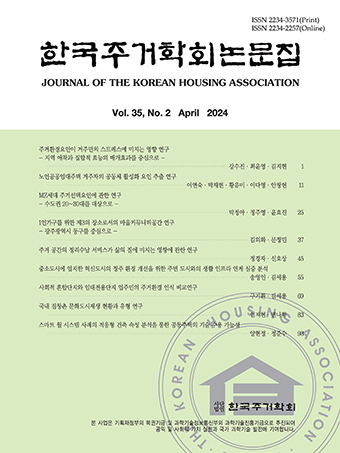References
An, S. C. (2017). The study on consciousness research on supplying the youth-housing. Unpublished master's thesis, Seoul National University of Science and Technology University, Seoul, Republic of Korea.
Choi, H. I. (2015). Research in relation to the issues and development strategy regarding supply of public rental housing. Korea Institute for Aggregate Building Law, 15, 103-130.
Choi, M. J., & Hwang, K. H. (2002). Effectiveness of the incentives for securing public open space in urban design. Korea Planning Association, 37(3), 91-104.
Daegu Metropolitan City (2020). Retrieved from http://www.daegu.go.kr/YouthPolicy/index.do?menu_id=00936785&menu_link=/front/youthpolicy/selectYouthpolicy.do
Daejeon Metropolitan City (2020). Daejeon metropolitan city district unit plan establishment guidelines. Retrieved from Daejeon: Daejeon Metropolitan City.
End and Means (2007). The Future Roles of Social Housing In England, CASE Report34, Centre for Analysis of Social Exclusion. Brighton: England.
Kim, D. N. (1986). Access time distribution of subway users. Journal of Korean Society of Transportation, 4(1), 28-40.
Kim, J. (2012). Empirical study on estimating the walking distances of users in catchment area according to characteristics of land use. Unpublished master's thesis, Hanyang University, Seoul, Republic of Korea.
Kim, S. Y. (2013). Current status and challenges of youth housing problems. Korean Center for City and Environment Research, Vol.102, 9-19.
Korea Ministry of Government Legislation (2020). Law search sheets. Retrieved from http://www.law.go.kr/LSW/eng/engLsSc.do?menuId=2&query
Lee, C. M., Choi, S. E., Park, H., & Park, H. Y., (2009). Demand characteristics of public rental housing near a duble-crossing subway station. Seoul Studies, 10(4), 191-207.
Lee, J. Y., & Song, T. S. (2004). Analysis of the change of subway access areas area and subway user's behaviors in the new town of the capital region. Korea Planning Association, 39(4), 93-104.
Lee, Y. S. (2012), A study on the spatial boundaries of subway station areas in the city of Seoul. Unpublished master’s thesis, Hongik University, Seoul, Republic of Korea.
Ministry of Land, Infrastructure and Transport (2020). Retreived from http://www.molit.go.kr/housingroadmap/main.jsp.
Naver Korean Dictionary(NAVER) (2020). Retrieved from https://ko.dict.naver.com/#/entry/koko/3139ceacd9d7482d8ed6e44da7258943
Seoul Metropolitan Government (2020). Retrieved from https://news.seoul.go.kr/citybuild/archives/509679?tr_code=short
Song, H. S., & Kim, J. H. (1995). A study on residents desire of the commercial facilities development in the station district. Daegu: Keimyung University, Industrial Technical Laboratory, Vol.18, 61-76.
- Publisher :The Korean Housing Association
- Publisher(Ko) :한국주거학회
- Journal Title :Journal of the Korean Housing Association
- Journal Title(Ko) :한국주거학회논문집
- Volume : 31
- No :6
- Pages :121-132
- Received Date : 2020-10-30
- Revised Date : 2020-12-11
- Accepted Date : 2020-12-15
- DOI :https://doi.org/10.6107/JKHA.2020.31.6.121



 Journal of the Korean Housing Association
Journal of the Korean Housing Association






